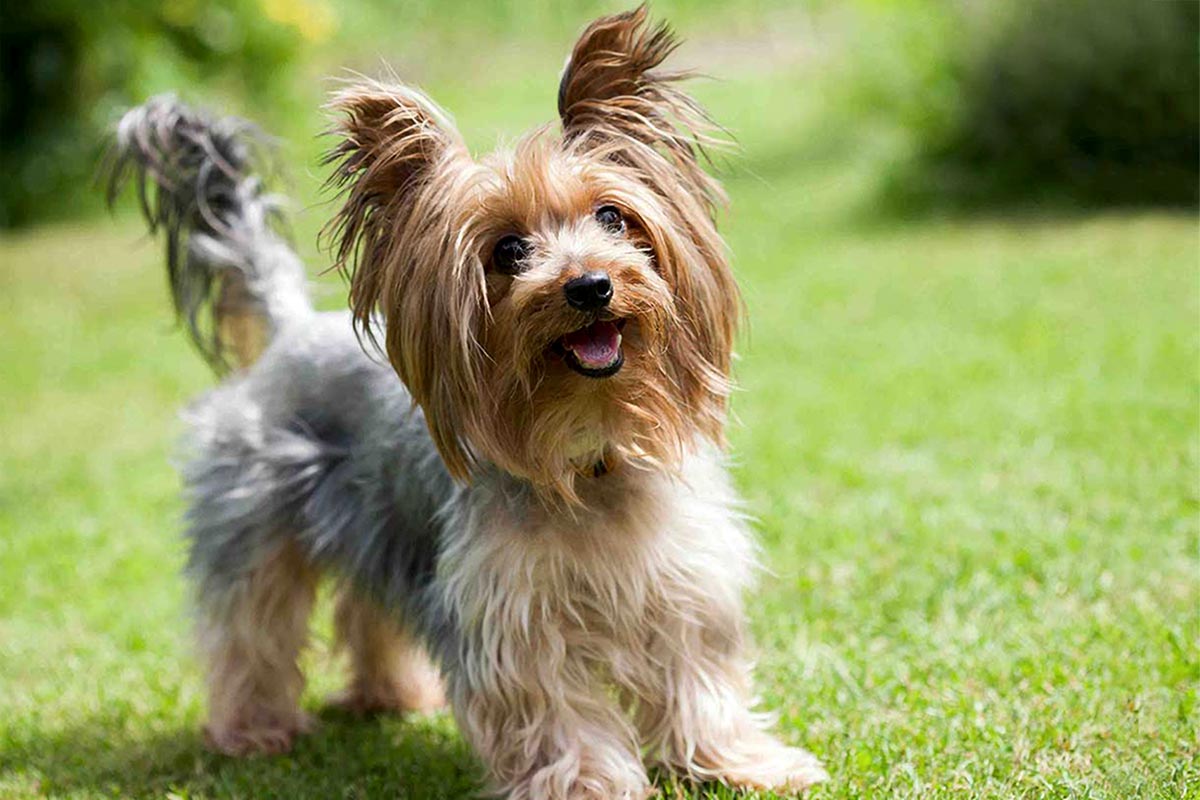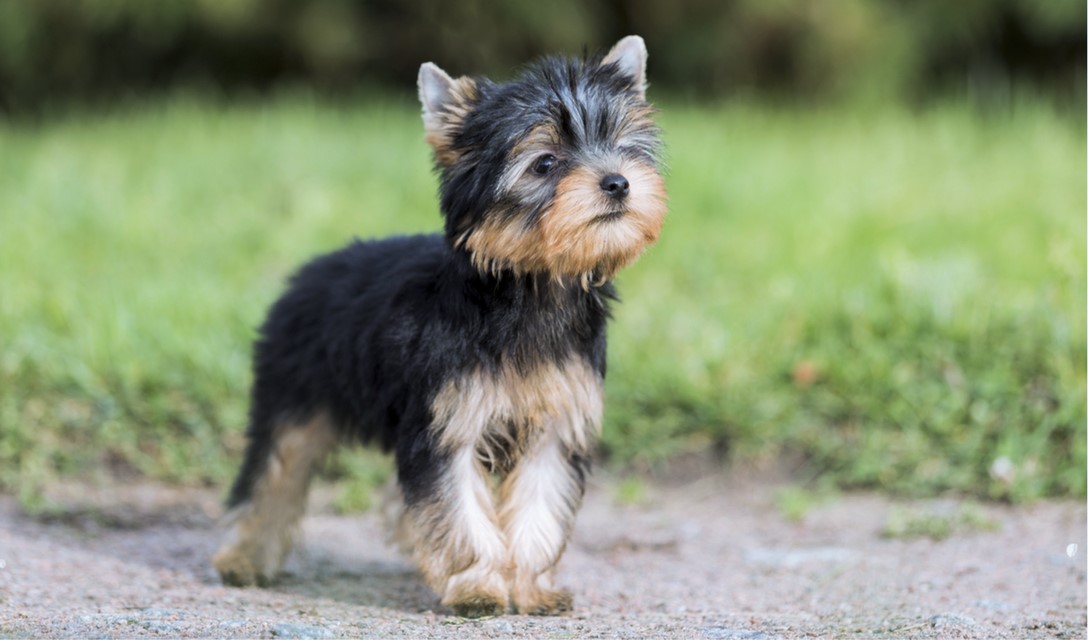The Yorkshire Terrier is often thought of as the lap dog of the rich and famous. In fact, this small and cheerful dog loves to exercise and play. Find out everything about the Yorkshire Terrier dog breed here.
Yorkshire Terriers are among the most popular pedigree dogs among dog lovers. Here you will find the most important information about the Yorkshire Terrier.
Size: very small
Weight: up to 3.2 kg
Coat length: medium length
Coat Color: Steel blue, lighter on chest
Country of origin: Great Britain
Origin of the Yorkshire Terrier

At the beginning of the industrial revolution, many Scots were drawn to the county of Yorkshire because there was work and a family income there. Dogs such as the Skyeterrier or the Clydesdale, which no longer exists today, were brought from home, whose task was to hunt rats and mice. They also helped hunt down a few rabbits, which added to the family’s diet. Small in stature, though not nearly as tiny as it is today, the dog itself didn’t need much food, which suited the tight budgets of working-class families.
Poor families deliberately bred the small terriers from the 19th century. Eventually, the dog won the hearts of the wealthier and even the nobility, making breeding rewarding. Today, the Yorkshire Terrier is often branded as a fashion dog and luxury pooch with a long silky coat and a red bow, carried around in celebrity bags.
The appearance of the Yorkshire Terrier
The Yorkshire Terrier is a very small, delicate and compact dog with an upright posture. With a maximum size of 20 to 25 cm, the Yorkshire Terrier is the smallest of all terrier species. At the same time he is a dwarf dog. Its head is small and flat, eyes are medium sized and dark, ears stand up in a V-shape.
Coat and colors of the Yorkshire Terrier
The Yorkshire Terrier’s fine, silky coat is medium-length, straight and shiny. The Yorkshire Terrier’s coat is steel blue from the occiput to the base of the tail, but is a lighter shade on the chest. The Yorkshire Terrier does not change its coat like other dogs. Instead, it just keeps growing.
Temperament and training of the Yorkshire Terrier
The Yorkshire Terrier has a very brave, happy and self-confident nature. Despite his small size, he is not afraid of anything, including other, larger dogs. In addition, the Yorkshire Terrier is very intelligent and alert. He has a natural hunting instinct.
The Yorkshire Terrier should be raised consistently and yet lovingly. He can and wants to learn, but as a terrier he also has a certain stubbornness and often a tendency to overestimate himself. Unfortunately, many owners don’t bother, because they succumb to the misconception that such a dwarf dog doesn’t have to or can’t be trained, and so the breed has the reputation of a spoiled lap dog or that of a wild, barking, (flexi) leash bullying hand brush.
The Yorkshire Terrier should be used to other dogs from an early age. It is important that the Yorkshire Terrier, despite its small size, be treated like a normal dog that is not being carried around all the time. If you have little experience in training dogs, find a dog trainer right from the start who will train you and your Yorkie in the basics. Any well-bred Yorkshire Terrier is an asset to the family and environment, and helps improve the breed’s image.
Keeping and caring for the Yorkshire Terrier

Contrary to the typical image of the Yorkshire Terrier in a handbag, the cheerful little dog really likes movement. While he can be kept well in the city and even in the small apartment, he definitely wants to go for a walk outside every day. He even likes to go on hikes if he is fit and well trained.
Children should be understanding and careful with the small dog. The Yorkshire Terrier can be a great family dog, but you should always keep an eye on the child and the dog, firstly so that the dog is not harmed, and secondly so that the dog does not have to defend itself against rough treatment with its teeth.
To compensate for his hunting instinct, the Yorkshire Terrier can be enthusiastic about hunting and search games in which he can use his nose. Many members of the breed love to dig and should be given the opportunity to do so. The little dog is also enthusiastic about fetch games. In addition to physical exertion, the Yorkshire Terrier must also be mentally challenged. With small intelligence games he stays mentally fit and happy.
Grooming is the be-all and end-all for the Yorkshire Terrier. It doesn’t matter how long the coat is: it has to be groomed daily with a comb and brush. A lovingly designed grooming ritual with treats and lots of praise when the dog keeps still, perhaps on the sofa in the evening, should be part of it right from the start.
Care should also be taken to ensure that the Yorkshire Terrier’s coat does not become too long. Since the little terrier does not change its coat, it must be trimmed regularly. Care should be taken to ensure that the hair does not interfere with the dog’s movement or catches the eye as this can become irritated. The typical Yorkshire Terrier braid has no fashion purpose, but helps to keep hair out of the eyes.
Since the Yorkshire Terrier does not change its coat, it hardly sheds and is often an option even for allergy sufferers. Like many dog breeds, Yorkshire Terriers have to deal with various health problems.
This includes:
- patella dislocation
- progressive retinal atrophy (genetic testing)
- lens luxation (gene test)
- secondary glaucoma
- distichiasis
- tracheal collapse, a narrowing or folding of the windpipe
- hydrocephalus (Water Head)
- non-closing fontanel
- misaligned teeth and persistent milk teeth
Despite being susceptible to many diseases, the Yorkshire Terrier has a long life expectancy of up to 15 years.